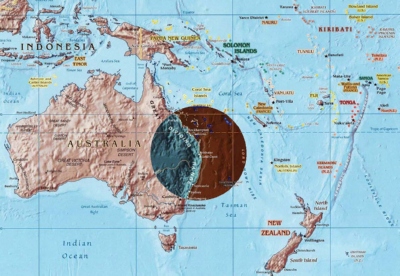

|
|
||||||||||||||||||||||||||||||
|
||||||||||||||||||||||||||||||
|
|
|
|
||
 |
Regular Ducting Conditions along the South East coast GREEN indicates permanent daily troposcatter, up to 340 km. YELLOW indicates regular tropo reception, with a range of 340 - 495 km. BLUE indicates rare tropo reception, with a range of 495 - 1,090 km. This illustration is intended as a rough guide to marine-based tropospheric ducts received with a five-element FM antenna. It should not be considered exhaustive. Virtually anything is possible! For simplicity, it does not include low probability marine-based tropo openings to locations such as Cairns, the Pacific Island of Norfolk or Hamilton in New Zealand. Nor does the chart include infrequent inland tropo openings over the Great Dividing Range to locations such as Roma, Lightning Ridge or Tamworth. All images on this page can be enlarged by clicking your mouse onto the image. Regular Sporadic E Conditions on the South East coast GREEN REGIONS indicate very common Es reception. ORANGE REGIONS indicate relatively common Es reception. This illustration highlights the regions where I receive the majority of my reflected Es (Sporadic E) 'visitors' from! You may notice that stations in the Australian state of New South Wales are rarely heard. This anomaly occurs because of the donut effect which applies to Es propagation. Only FM stations a certain distance away can be propagated via Sporadic E. The donut effect impacts Sporadic E from Brisbane What is the donut effect? The inverted section, directly surrounding the receiving location in Brisbane, is an Es DX 'dead zone' - the donut hole. What does the 'dead zone' mean? Evidence suggests it is probably impossible to receive reflected Es signals from FM stations that are broadcasting approximately 400 kilometres away from your location, or closer. In addition, FM stations less than 900 kilometres away, for example, stations in Sydney, are rarely heard. In summary, the donut effect simply means those in Brisbane are unlikely to receive Rockhampton, Gladstone and Bundaberg FM stations via Sporadic E propagation. However, these locations can be received by tropo propagation, so it ultimately balances out. Infrequent Sporadic E conditions occurring in Brisbane  Please be patient while the above animation loads. These paths are probably infrequent, having been heard here only once or twice. Falling into this category are low powered South Pacific FM stations broadcasting within 50-250 watts of Effective Radiated Power.
Also included are the type of paths that scientists presume to be multiple Es relections from the ionosphere.
Such paths are referred to as a 'double hop' path. One example is the reception of Darwin FM stations, where the radio waves have reflected 2,830 kilometres into Brisbane. Turning our attention to the Northern Hemisphere, it is breathtaking to consider that in regions such as the United Kingdom and Northern Ireland, 'triple hop' paths of FM stations via multiple Es reflections have occurred. Listen to record-breaking long distance FM reception on Mike's site & Paul's site. Illustration of the Troposphere & Ionosphere
 Image: University of Tennessee, Department of Physics & Astronomy It is generally accepted that:
|
|
|
|
||
| Site Map |
